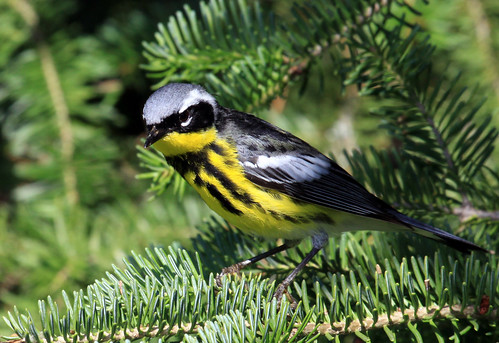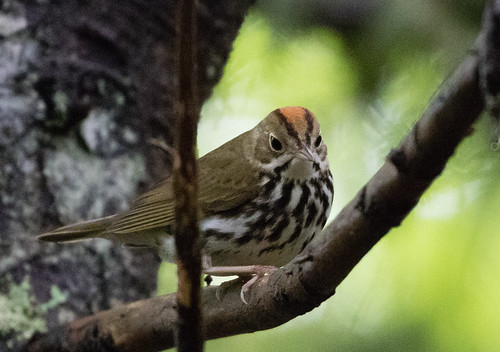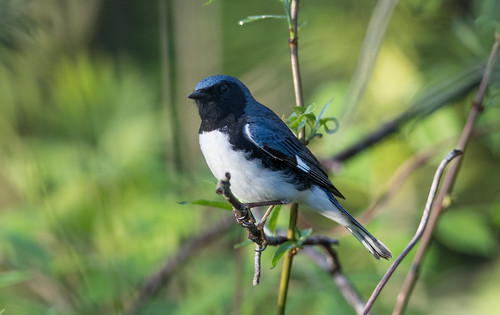 |
| Northern Parula |
Every year when May rolls around, I start waxing euphoric about warbler migration. My Zoom presentation at the start of this month was about them, and I covered every warbler species that regularly occurs in the United States and Canada, but at the end of my talk, looking at questions in the chat box, I realized I hadn’t addressed the most basic question of all—what IS a warbler? How exactly are they set apart from every other little songbird?
 |
| Magnolia Warbler |
Warblers are tiny insectivorous birds belonging to a big family limited to the Americas. They were unknown to European naturalists until explorers started shooting them and sending the carcasses back to Europe for cataloguing. Two of our warblers, the Northern Parula and American Redstart, were included in the 10th edition of Linnaeus’s Systema Naturae published in 1758. Linnaeus placed the redstart in the genus Motacilla, which now, in 2021, is limited to what we call “wagtails,” mostly Eurasian species, but in 1758, it was a big, amorphous genus that also included our bluebird.
 |
| American Redstart |
I’d always been curious about the similarity of the chickadee family name, Paridae, and the warbler family name, Parulidae—it was all because Linnaeus mistook the Northern Parula for a European tit and placed it in the genus Parus.
 |
| Northern Parula |
Linnaeus had codified the binomial system, giving each species of plant and animal a unique Latinized scientific name, in 1735. Placing birds in families took longer and working out logical ways of classifying birds is still a work in progress. Understanding relationships among birds is as tricky as working out family histories for humans. Someone who could easily pass for your sibling might have ancestors from an entirely different part of the world than yours. Relationships between warblers and other birds took a long time to sort out and is still in flux. The family as we know it now was defined by Alexander Wetmore in 1947. (Before that, wood warblers were placed in Mnilotiltidae.) The name common nickname “warbler” came from the European warblers, who actually do warble—most of our species have thin, buzzy songs that couldn't be described as warbles, and most of our species are much more colorful. So what defines the family, making them actual warblers?
Our warblers are all small, from the tiniest, the Northern Parula and Lucy's Warbler, which are only 4 1/4 inches from tip of beak to tip of tail, to the biggest, the Ovenbird and Louisiana Waterthrush, which are 6 inches long.
 |
| Ovenbird |
It's easy for both beginners and experienced birders to confuse kinglets, gnatcatchers, and vireos with warblers, and wrens, creepers, nuthatches, and even chickadees can confuse beginners. Our Ovenbird and the Northern and Louisiana Waterthrush spend time on the ground and look a LOT like small thrushes, a problem that is exacerbated because the Ovenbird and waterthrushes aren't much smaller than thrushes. Over the years, I've several times confused, at first glance, a young or female Orchard Oriole or female tanager with a warbler, and when I was starting out, I mistook goldfinches for warblers until I got better at paying attention to the bill thickness and posture.
 |
| Yellow-rumped Warbler |
Warbler bills are slender and straight—thinner and longer than those of chickadees, without the curve of a Brown Creeper’s bill or the hooked tip of a vireo’s, and longer than the bills of kinglets. Paying attention to such subtleties becomes second nature with experience. When I was starting out, I thought of warblers as yellow, but so are goldfinches and female orioles and tanagers, and many warblers have no yellow at all. Some warblers have oval spots on the underside of their tail tips which are, I think, a unique warbler trait, but many common warblers don't have those.
 |
| Black-throated Blue Warbler |
Our warblers all have 9 primary wing feathers, but so do some small songbirds from other families. Back before DNA helped work out relationships, scientists used various morphological structures, such as the syrinx or songbox, various muscle groups, and other structures we can’t possibly see when we’re looking at a tiny songbird and just want to know where to find it in our field guide.
Too bad birds can't each wear their 23andme results on conspicuous wing tags. Of course, birds don't have 23 pairs of chromosomes—most songbirds have 40. Not knowing anything about genetics when I started birding, the way I learned my warblers was to spend a lot of time birding, and a lot of time with my field guides. I read both the Peterson and Golden Guides from cover to cover, but just a tiny bit actually stuck. What really helped was keeping the field guides out in our apartment, one next to the bed. A few times every day I'd open one at random and read a page or two. Little by little, my brain started absorbing the information in a way that became accessible in the moment I was actually seeing those birds.
I did two things to master bird songs. First, when I heard anything, I'd track it down--the intense search helped cement the song in my head. Also, when I was in the kitchen, or ironing (back when I actually did ironing), or doing homework (I was still a student), I'd listen to recordings. My brain would drift a lot, but doing it so often, some of it started to stick. I'll never forget when I went out West with my sister-in-law in 1979 and heard my first MacGillivray's Warbler. I swear I could hear the nasal voice on the Peterson record, in my brain say, perfectly clearly, "Page 254 (or whatever page it was), MacGillivray's Warbler." That moment made all the hours of listening worth it! Plus listening over and over sealed into my brain the songs I was getting more familiar with outdoors.
It's fun and easy to get out there and see warblers. Figuring them out is the challenge. But try not to get frustrated. Life is too short and warblers too wonderful to let mere issues of identification stop us from enjoying them!
 |
| Blackburnian Warbler |